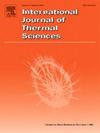Large eddy simulation on thermal striping of liquid lead-bismuth eutectic in parallel five-jet
IF 4.9
2区 工程技术
Q1 ENGINEERING, MECHANICAL
International Journal of Thermal Sciences
Pub Date : 2025-03-22
DOI:10.1016/j.ijthermalsci.2025.109870
引用次数: 0
Abstract
Thermal striping in the upper plenum of the lead-cooled fast reactor (LFR) is a temperature fluctuation phenomenon caused by the mixing of two non-isothermal fluids, and can lead to high cycle thermal fatigue and cracks in adjacent structures. Quantitative study of thermal striping is of great significance for the safe operation of reactors. This paper studies the thermal striping phenomena of lead-bismuth eutectic in a parallel five-jet plenum based on large eddy simulation. The parametric effects on characteristics of temperature fluctuation in terms of its statistics and flow structures are focused on, including the effects of temperature differences and velocity ratios. The results show that the temperature difference and velocity ratio significantly affect the flow patterns of thermal and flow fields, as well as the statistical characteristics of thermal striping. Under isovelocity conditions, the flow pattern of fluids is symmetric, whereas it is affected by velocity ratio in non-isovelocity scenarios. With isovelocity, increasing temperature difference raises the average temperature, heat flux and temperature fluctuation intensity. For non-isovelocity conditions, higher velocity ratios reduce average temperature but increase heat flux, with temperature fluctuation intensity showing an initial increase followed by a decrease. Spectral analysis indicates that the temperature difference primarily increases the temperature fluctuation amplitudes (the dominant frequency stabilized at about 5 Hz). Conversely, increasing velocity ratio decreases the amplitude and raises the dominant frequency. These findings provide valuable insights for understanding the mechanism of thermal striping of liquid lead-bismuth eutectic.
平行五射流中液态铅铋共晶热条带的大涡模拟
铅冷快堆(LFR)上部静压室内的热条纹是由两种非等温流体混合引起的温度波动现象,可导致相邻结构的高周热疲劳和裂纹。热条带化的定量研究对反应堆的安全运行具有重要意义。基于大涡模拟,研究了铅铋共晶在平行五射流腔内的热条形现象。重点分析了温度波动特性在统计和流动结构方面的参数影响,包括温差和速度比的影响。结果表明,温差和速比显著影响热场和流场的流动形态,以及热条纹的统计特性。在等速条件下,流体的流型是对称的,而在非等速条件下,流体的流型受流速比的影响。等速下,温差增大,平均温度、热流密度和温度波动强度增大。在非等速条件下,较高的速度比降低了平均温度,但增加了热流密度,温度波动强度先增大后减小。频谱分析表明,温差主要增加了温度波动幅度(主导频率稳定在5hz左右)。反之,速度比的增大会减小振幅,提高主导频率。这些发现为理解液态铅铋共晶的热条带化机理提供了有价值的见解。
本文章由计算机程序翻译,如有差异,请以英文原文为准。
求助全文
约1分钟内获得全文
求助全文
来源期刊

International Journal of Thermal Sciences
工程技术-工程:机械
CiteScore
8.10
自引率
11.10%
发文量
531
审稿时长
55 days
期刊介绍:
The International Journal of Thermal Sciences is a journal devoted to the publication of fundamental studies on the physics of transfer processes in general, with an emphasis on thermal aspects and also applied research on various processes, energy systems and the environment. Articles are published in English and French, and are subject to peer review.
The fundamental subjects considered within the scope of the journal are:
* Heat and relevant mass transfer at all scales (nano, micro and macro) and in all types of material (heterogeneous, composites, biological,...) and fluid flow
* Forced, natural or mixed convection in reactive or non-reactive media
* Single or multi–phase fluid flow with or without phase change
* Near–and far–field radiative heat transfer
* Combined modes of heat transfer in complex systems (for example, plasmas, biological, geological,...)
* Multiscale modelling
The applied research topics include:
* Heat exchangers, heat pipes, cooling processes
* Transport phenomena taking place in industrial processes (chemical, food and agricultural, metallurgical, space and aeronautical, automobile industries)
* Nano–and micro–technology for energy, space, biosystems and devices
* Heat transport analysis in advanced systems
* Impact of energy–related processes on environment, and emerging energy systems
The study of thermophysical properties of materials and fluids, thermal measurement techniques, inverse methods, and the developments of experimental methods are within the scope of the International Journal of Thermal Sciences which also covers the modelling, and numerical methods applied to thermal transfer.
 求助内容:
求助内容: 应助结果提醒方式:
应助结果提醒方式:


